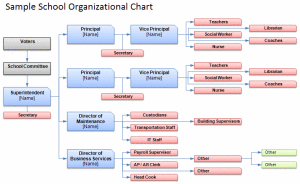Articles
ORGANIZATIONAL STRUCTURE OF SCHOOLS
By Scott Wolfenden
A school’s organizational structure can affect the teacher’s attitude and teaching style. Schools can have several types of organizational structures. Some of these structural frameworks include traditional or bureaucratic, loosely coupled systems and interdisciplinary team organization (ITO). The structure of the school can affect teachers’ attitudes towards teaching and work satisfaction, as well as the graduation rate of the students. 
Bureaucratic Model
A traditional or bureaucratic school structure focuses on a top-down approach. Decision-making starts at the top with the policies of the school district and works its way down to principals and finally to teachers. It is highly structured, and the teacher’s role in decision-making is limited.
Loosely Coupled Systems
In a loosely coupled organizational structure, teachers have a great deal of autonomy. However, there may not be much goal setting on the part of the school or fluidity between departments.
Interdisciplinary Team Organization (ITO)
In an interdisciplinary team organization (ITO) structure, teachers from two or more fields have a common planning period and work as a team with a shared body of students. This form of structure is most commonly used in middle schools, but is also sometimes used in high schools. Interdependent collaboration can have a beneficial effect on teacher morale and the quality of presentation.
Effects
A study conducted by researchers from the University of Hawaii and published in the “American Journal of Education” concluded that a school’s structure could measurably affect student performance.
HIT THE PAUSE BUTTON ON COSTLY BONDS
Press Democrat Editorial 1/29/2013
Would you take out a loan if you had to pay $10.80 in interest for every dollar your borrowed? Maybe if you were desperate. But if you own property in Santa Rosa’s Bellevue School District, those are the terms of a bond issue completed in 2011, according to a database compiled by the Los Angeles Times.
By the time the $378,000 loan is paid off, taxpayers in the district will fork over a little more than $4 million in interest. In the Fort Bragg Unified School District, a 2011 bond issue includes $8.60 in interest payments for every dollar of principal. Remarkably, you don’t have to look very hard to find terms that are even worse. Elsewhere in the state, the database shows debt ratios are running as high as 23.4:1 — $23.40 in interest for every dollar of principal. Those terms would make a loan shark blush. Apparently some school officials didn’t blink.
These high-cost loans are financed with capital appreciation bonds, a funding mechanism that allows borrowers to put off payments for years, sometimes decades. At least 200 school districts have used them to borrow money for construction and maintenance, building upgrades and technology. Last week, state Treasurer Bill Lockyer and state schools Superintendent Tom Torlakson requested a moratorium on capital appreciation bond financing. “Too frequently, (school) board members and the public have not been fully informed about the costs and risks associated with CABs,” they said in a letter to school superintendents around the state. “In some cases, board members have reported they were not even aware they approved the sale of CABs.”
a moratorium on capital appreciation bond financing. “Too frequently, (school) board members and the public have not been fully informed about the costs and risks associated with CABs,” they said in a letter to school superintendents around the state. “In some cases, board members have reported they were not even aware they approved the sale of CABs.”
For some districts, deferring interest payments offers a political advantage: They can promise voters that authorizing a general-obligation bond won’t result in an immediate property tax increase. Another reason districts use CABs is that deferring payments allows them to comply with statutory caps on property tax assessments for bond debt.
But deferring payments — in some instances for 25, 30 and even 40 years — means that many of the people who pay the bill will never benefit from capital improvements financed by the loan. “We are convinced that remedial legislation is needed to prevent abuses and ensure that both school board members and the public obtain timely, accurate, complete and clear information … before CABs are issued,” Lockyer and Torlakson said in their letter.
Gov. Jerry Brown “told us he wants reforms,” they said, adding that “key lawmakers and legislative leaders” agree. We do, too. There may be times when CABs and other deferred-payment loans make sense. A brief moratorium won’t change that. But it’s crystal clear that California taxpayers are being fleeced and that all taxpayers are entitled to transparency.
School districts should listen to Lockyer and Torlakson, and state lawmakers should start the oversight process before the interest costs get any bigger.

Recent Comments